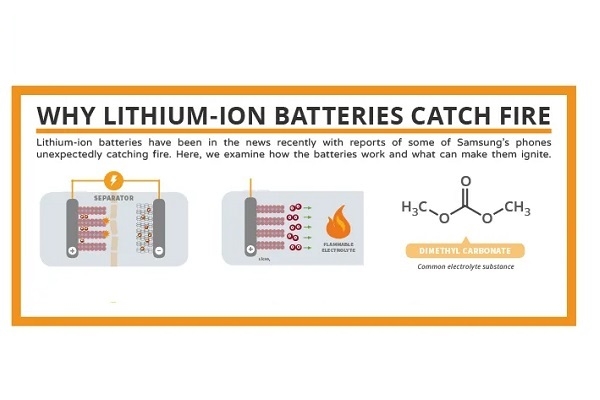Lithium-ion batteries are widely used in various electronic products such as mobile phones, laptops, tablets, digital cameras, electric toys, power banks, etc. due to their high output voltage, high energy density, long cycle life, long shelf life and no memory effect. However, due to the high energy density of lithium-ion batteries and many combustible components, the risk of fire is relatively high. In recent years, fires caused by lithium-ion batteries have occurred frequently. Many airplanes, such as Emirates Airlines Boeing 777, UPS Airlines Boeing 747 freighter, Japan Airlines Boeing 787 passenger aircraft, etc., had accidents caused by lithium-ion battery fire and even crashed. News such as mobile phone charging fire, mobile phone battery explosion, power bank fire and smoke, etc. are often seen in the newspapers. According to statistics, more than 10 million laptop batteries have been recalled globally for similar reasons.

The main cause of lithium-ion battery fire
The main components of lithium-ion batteries include positive electrode, negative electrode, electrolyte, separator, positive electrode lead, negative electrode lead, safety device and battery casing, etc. Most of the materials are combustible materials. The distance between the positive and negative electrodes of a lithium-ion battery is extremely short. Any small defect on the separator between the positive and negative electrodes may form a short circuit, causing local high temperature, and causing the separation of the positive and negative electrodes in nearby locations to decompose and chain The reaction will eventually cause the battery to catch fire or explode.
Common causes of internal short circuits in lithium-ion batteries
(1) Manufacturing defects
In the production process of lithium-ion batteries, the production process is extremely demanding. The tiny metal particles mixed in the separator during the production process, the burrs that may appear during the cutting process of the positive and negative plates, and the separator during production, transportation, storage and assembly Defects such as uneven thickness and tearing formed during the process may cause short circuits between the positive and negative electrodes of the battery. Lithium-ion batteries have to undergo a series of processes such as charging and discharging after the assembly is completed. These processes are accompanied by physical processes such as vibration and heat generation. This process may magnify the defects of the diaphragm and eventually cause a short circuit. Under the current technical conditions, these defects are difficult to be found and detected in the production process, and the influx of defective products into the market will bring potential fire hazards. Those with poor technical conditions or the quality of batteries produced by informal manufacturers are more difficult to guarantee, and the probability of causing fires is also greater.
(2) Mechanical injury
During transportation, storage, and use of lithium-ion batteries and products assembled with lithium-ion batteries, mechanical damage such as squeezing, acupuncture, and falling due to external forces on the lithium-ion battery may easily lead to direct positive and negative poles short circuit in the battery and causing a fire.
(3) Poor storage environment
If lithium-ion batteries and products assembled with lithium-ion batteries are stored and used in harsh environments such as high temperatures, their separators are easily decomposed by heat, resulting in a short circuit between the positive and negative electrodes in the battery causing a fire.
(4) Overcharge and overdischarge
Overcharging and discharging the lithium-ion battery by users during use will cause the metal crystals in the battery to become larger, which may pierce the diaphragm, cause an internal short circuit in the battery, and cause thermal runaway and cause a fire.
Suggest
1. When purchasing lithium-ion batteries and related products, you should carefully choose products from regular manufacturers and choose chargers that match the battery voltage and current.
2. When charging lithium-ion batteries and related products, they should be charged correctly according to the instructions to prevent the charging time from being too long.
3. When storing, moving, and using lithium-ion batteries and related products, try to prevent the batteries from being bumped, squeezed and other strong external uses.
4. The storage and use of lithium-ion batteries and related products in high temperature and other environments should be prevented.
For lithium-ion batteries, thermal runaway is the most serious safety accident. Once thermal runaway of lithium-ion batteries occurs, it is difficult to stop its reaction. Phased warnings can be made at the initial stage of thermal runaway, and different protective measures can be taken to suppress the spread of thermal runaway. Such as strengthening the battery cooling system, covering the insulation layer, and isolating the air asphyxiation.



